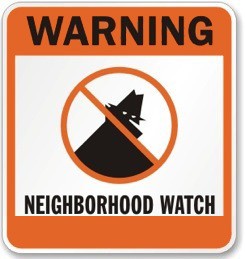
Starting a Neighborhood Watch program in your neighborhood is not hard, but it will take a little time and some proper planning.
Step One: Getting started
- Visit the USAOnWatch.org website which is the national face of the Neighborhood Watch program. There you will find great information to help you get started.
- Determine the area you want to organize. This should be the area you consider your "neighborhood". Groups can range in size from 5 to 150 households. The larger the area, the greater the protection.
- Find neighbors to assist you. These people will form your initial group of Neighborhood Watch Volunteers. A good number would be one person per 8 to 10 households. Determine the best night of the week for a presentation. Most Neighborhood Watch presentations are held during the evening hours, Fridays and weekends are not recommended.
- Set up a free neighorhood watch website to help coordinate and communicate your efforts. See this article on how to use a website with the neighborhood watch program.
Step Two: Contact the Sheriff's Office to schedule speakers
- Contact Your Local Sherri's Office or Police Departemnt
- Arrange a meeting location close to your neighborhood. It should have enough room to hold your invited neighbors and, if needed, for the use of audio visual aids such as an overhead projector.
Step Three: Invite your neighbors
- Distribute the invitations at least 2 weeks prior to the meeting. The most effective way to do this is to ask the Neighborhood Watch volunteers to hand-carry them to neighbors and ask if they will attend. Get names and phone numbers if possible to make reminder calls later.
- Distribute a meeting "reminder" notice 3 days before the meeting or make personal phone calls.
Step Four: Prepare a neighborhood map
- Prepare a Neighborhood Watch area map or plat plan showing names, phone numbers and street number of each household.
Step Five: The presentation
At the presentation you will:
- Identify concerns and develop an action plan.
- Learn crime prevention techniques such as home security, personal safety and Operation Identification.
- Learn how to report suspicious activity.
- Meet your neighbors and establish a communication network (telephone tree).
- Recruit your Coordinator and Block Captains.
- You will learn how to order Neighborhood Watch signs.
Step Six: Maintenance
- Once your neighborhood has been organized, maintaining interest in Neighborhood Watch is important. It's too easy for us to forget to keep that vigilance we thought was so important in the beginning. Some groups maintain interest by planning neighborhood outings, meetings, summer picnics and passing out a Neighborhood Watch Newsletter every month.
For More Information:
- Find Out How to Get A Free Neighborhood Watch Website
- See this other article for an overview and more resources on Neighborhood Watch-What is It?
- Step by Step Guide: How to Start a Neighborhood Association
- USA On Watch-The Face of the National Neighborhood Watch Program
- Tools and Resoures from the National Crime Prevention Council
Source: USAOnWatch.org and the National Crime Prevention Council
 Print
Print Email
Email







